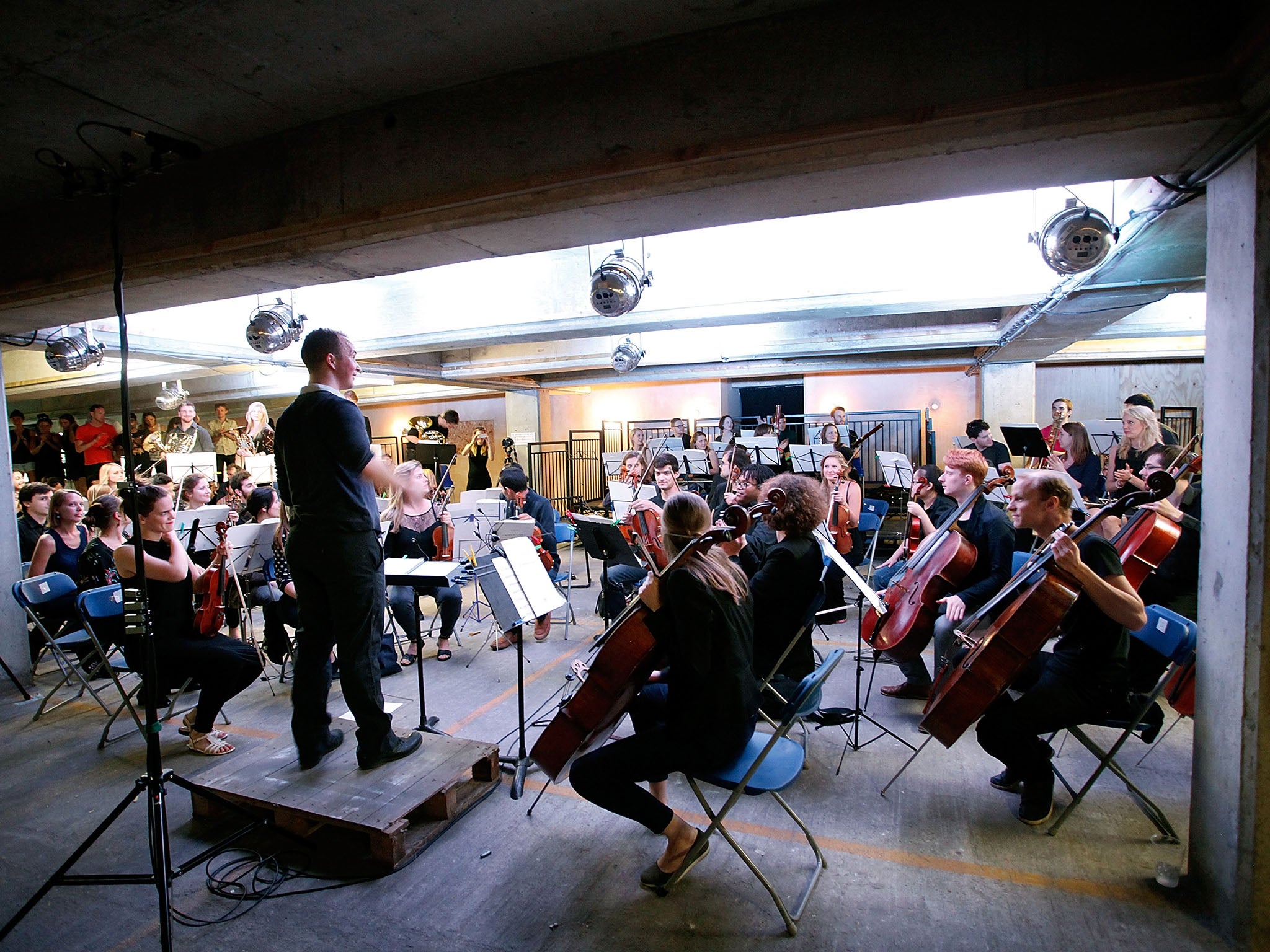New lease of life: How disused car parks are being transformed into cultural centres
Disused car parks across the UK are becoming galleries, concert halls and bars

The car park is being reinvented.
And, perhaps surprisingly, art is at the forefront. We are turning multi-storeys into galleries, parachuting hipster sculpture parks on to car-park roofs, flipping parking spaces into cool living spaces, and re-appraising parking architecture.
Next month, at the unassuming Hurst Street car park in Birmingham, the city’s Ikon Gallery and Hippodrome theatre will be hosting the About Town festival of video art – showing Gillian Wearing’s Broad Street, which depicts tipsy clubbers in 2001 on the city’s main nightlife drag, and Oliver Beer’s Pay and Display – a collaboration with the Ex Cathedra choir, incredibly inspired by the eerie echo of a stairwell in a nearby Brum car park.
“The Brutalist car park where I made Pay and Display is matter-of-fact, prosaic architecture – but its acoustics are as pure and beautiful as those of any cathedral,” Beer says. “The building will be wiped out in the next phase of development, and for me the sound piece I made there was almost an aural cast of the architecture.”
You would have to be mad to drive a car into the centre of most cities. These days, we take the train or the bus. And so many car parks lie half-empty. “While changing lifestyles mean that there is less demand for parking, the public’s interest in art is greater than ever,” says Sean Bidder of The Vinyl Factory, who has set up a gallery inside Brewer Street car park in Soho – hosting work by Quentin Jones and Robert Storey. For fellow artist Lorenzo Belenguer, the car park beneath Cavendish Square in central London – where he exhibited this month as part of the Frieze Festival fringe – worked because “its Minimalist design makes it exceptionally suited for contemporary art”.
Since 2007, the Bold Tendencies group has transformed Peckham’s multi-storey into an annual outdoor gallery, topped by the trendy Frank’s Café. Now, small towns are joining in: Ruthin’s new Art Trail opened this February, and they’ve turned the boring height barriers on car parks in the North Wales town into sculpture – embedding them with retro photos or vintage train tickets.

In the US, they’re experimenting with living in car parks. Students at the Savannah College of Art and Design (Scad) have designed prototype digs – Scadpads. Cheap, colourful, parking-space-sized and perched high in Atlanta and Savannah multi-storeys – perfect, if you don’t have much stuff. “Parking structures haven’t been examined as opportunities for urban living,” believes Christian Sottile, the dean of Scad’s School of Building Arts. “We see these 20th-century structures as a huge opportunity to bring art and design together and sustainably evolve these buildings.”
But can car parks be works of art in themselves? Miami thinks so. It has commissioned garages from famous architects, such as the elegant “urban experience” at 1111 Lincoln Road, by the Swiss firm Herzog & de Meuron – which is currently working on a new Tate Modern gallery next to Bankside Power Station. Or Sheffield’s attention-seeking Charles Street car park by architects Allies & Morrison, which looks like a series of half-completed Rubik’s cubes, and won a Riba Award in 2009.
Even our maligned 1970s car parks can seem beautiful. Hove’s Norton Road car park and Birmingham’s Moat Lane and Newhall Street multi-storeys have a certain tough aesthetic to them. Illustrator Stephen Millership was beguiled by the sinuous car-park decks on top of Preston’s bus station, re-producing them recently as a poster in his kitsch Lost Destinations series.
Earlier this year, the Royal Society of Arts called for empty British car parks to be turned into drive-in cinemas, skating rinks or tennis courts. As our car parks increasingly lie empty, it seems ever more tempting to turn them into something more fun, swapping pay and display for play and display.
Join our commenting forum
Join thought-provoking conversations, follow other Independent readers and see their replies
Comments